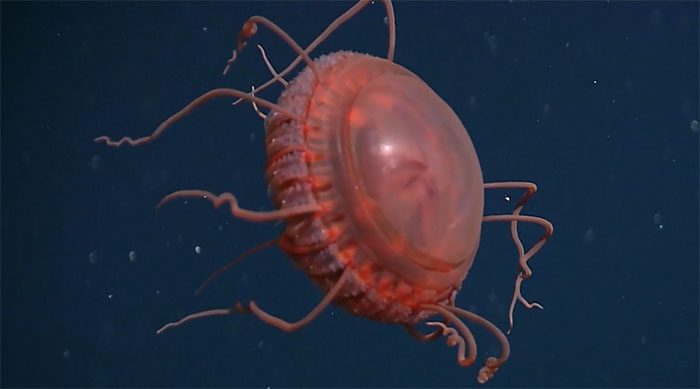The Monterey Bay Aquarium Research Institute Discovers an Unusual Crown Jellyfish Species of the Genus Atolla.
Deep-Sea Jellyfish Atolla is one of the most common creatures found in the dark depths of the ocean. Its bell is bright red with long, solitary tentacles, one of which is significantly longer than the others.

Fifteen years ago, the Monterey Bay Aquarium Research Institute (MBARI) discovered a jellyfish resembling Atolla, but lacking the characteristic super-long tentacles, which began to attract the attention of scientists.
After more than a decade of searching and collecting samples, the research team now has sufficient detailed information about the morphological and molecular characteristics of the organism to describe it as a new species in the journal Animals.
“We named this species Atolla reynoldsi in honor of Jeff Reynolds, the first volunteer at MBARI, to acknowledge the 4.3 million hours of work he and other volunteers have contributed to the aquarium over the past 38 years,” shared Dr. George Matsumoto, a senior researcher at MBARI.
Rare footage of the Atolla reynoldsi jellyfish. (Video: MBARI)
Atolla reynoldsi is relatively large compared to other Atolla species. The largest specimen collected by the team had a diameter of 13 cm, making it one of the largest members of the genus.
Like most deep-sea crown jellyfish, Atolla reynoldsi also has a small bell with a deep groove running around it. The dome-shaped bell is separated from the edge by thick segments known as pedalia. This new species has a distinctive gut that resembles a Greek cross.
“Although lacking complete information, Atolla reynoldsi is clearly distinct molecularly and morphologically from all ten previously described Atolla species,” Matsumoto emphasized.
In addition to Atolla reynoldsi, the research team also found two other jellyfish species believed to be new members of the genus Atolla, temporarily named Atolla A and Atolla B, but there is not yet enough information to confirm this.
“All three species – Atolla reynoldsi, Atolla A, and Atolla B – should probably be classified into a new genus due to their distinct stomach morphology and lack of long tentacles, but until further research is completed, we are still categorizing them under the genus Atolla,” Matsumoto added.


















































